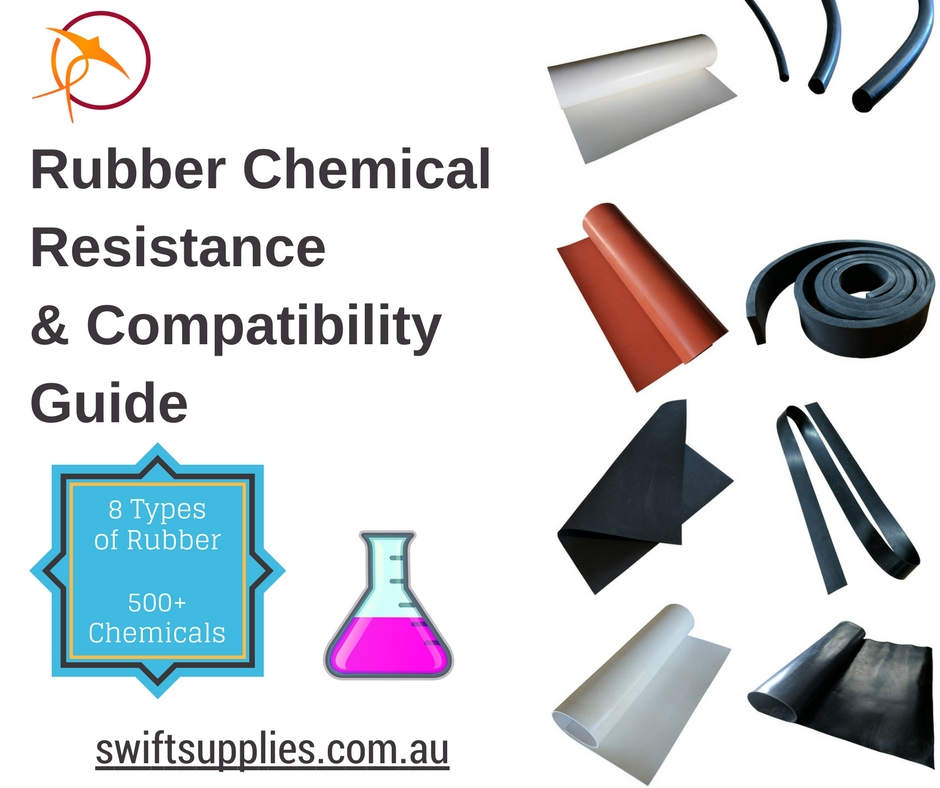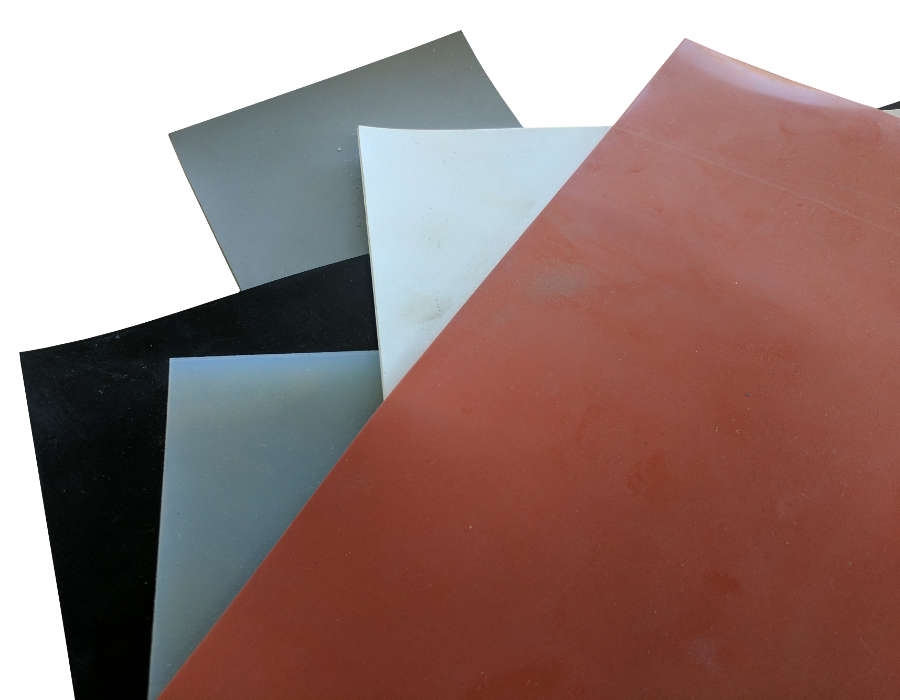 One of the most frequently asked questions we hear is about which rubber to use for sealing a particular type of fluid. Queries like “is Nitrile ok to use for sealing a petrol tank” or “can I use Silicone as a gasket for a LNG line” are quite common. With so many different types of rubber out there, and an almost infinite number of possible mediums, it’s pretty understandable.
One of the most frequently asked questions we hear is about which rubber to use for sealing a particular type of fluid. Queries like “is Nitrile ok to use for sealing a petrol tank” or “can I use Silicone as a gasket for a LNG line” are quite common. With so many different types of rubber out there, and an almost infinite number of possible mediums, it’s pretty understandable.
We’re always happy to help with these questions but part of our mission here at Swift is to provide as much information as possible. That’s why we’re very happy to announce the publication of our new rubber chemical resistance and compatibility guide.
We’ve worked to make this guide as comprehensive as possible. Right now, it includes information on over 500 different types of chemicals, liquids and media and covers 8 popular styles of rubber used for sealing and gaskets (expanded on below).
Of course, a rubbers compatibility with a particular chemical is only one of the factors contributes to seal performance. It’s very important, but it is not everything. Amongst other things (like how the gasket is to be installed) you should also consider…
- The Grade of the Elastomer.
There are many, many different rubber manufactuers. All use slightly different formulas and variable amounts of filler compounds. The result is that Neoprene sheet from one manufactuer may, in fact, be quite different to Neoprene sheet from another. Variable levels of purity will result in different levels of chemical resistance and seal performance. - The Temperature of Service.
Elevated temperatures increase the affect that a chemical or media will have on an elastomer. The degree of the increase will vary depending on the particular type of rubber and the chemical. As a result, a rubber that might seal a particular chemical perfectly well at room temperature could fail if subjected to higher temperature conditions. - The Durometer / Hardness of the Rubber.
Generally speaking, the harder the rubber material, the greater its chemical resistance. - Conditions of Service.
A rubber that swells when used in conjunction with a particular fluid may be perfectly fine for sealing in a static application yet fail in a dynamic sealing environment.
 Because of these limitations and the effect these additional factors can have on sealing performance, it is always best to test a sealing material in the actual sealing environment.
Because of these limitations and the effect these additional factors can have on sealing performance, it is always best to test a sealing material in the actual sealing environment.
Even with all this information, we’ll be the first to admit it doesn’t cover everything. We’ll keep updating the guide as we get new information on different chemicals or additional types of rubber are requested. In the meantime, if you need assistance finding the right rubber for a particular sealing job, or want to confirm your conclusions, please don’t hesitate to contact us. We’ll be happy to help in any way we can.
You can find our rubber chemical resistance guide here.
Different Types of Rubber Covered in our Chemical Resistance Guide
Natural Insertion Rubber
| Other Names | Natural Rubber (also Natural Rubber Insertion, Insertion Rubber or NRI) |
| Represented In The Table As... | NR / IR |
| ASTM Designation | NR / IR |
| Chemical Name | Polyisoprene |
| Typically Resistant To... | Most moderate chemicals (wet or dry), organic acids, alcohols, ketones, aldehydes. |
| Typically Attacked By... | Ozone, strong acids, fats, oils, greases, most hydrocarbons. |
| Available in Strip or Sheet (custom fabricated parts also available upon request) | |
Styrene Butadiene Rubber
| Other Names | Butadiene Rubber, BUNA-S, SBR |
| Represented In The Table As... | SBR |
| ASTM Designation | SBR |
| Chemical Name | Styrene Butadiene |
| Typically Resistant To... | Most moderate chemicals (wet or dry), organic acids, alcohols, ketones, aldehydes. |
| Typically Attacked By... | Ozone, strong acids, fats, oils, greases, most hydrocarbons. |
| Coming Soon in Sheet to Swift Supplies (SBR does serve as the binding rubber in our TS1521 Industrial Grade Cork Sheet) |
|
Butyl Rubber
| Other Names | N/A |
| Represented In The Table As... | IIR |
| ASTM Designation | IIR |
| Chemical Name | Isobutyllene Isoprene |
| Typically Resistant To... | Animal and vegetable fats, oils, greases, strong and oxidizing chemicals. |
| Typically Attacked By... | Petroleum solvents, coal tar solvents, aromatic hydrocarbons. |
| Coming Soon to Swift Supplies | |
EPDM Rubber
| Other Names | N/A |
| Represented In The Table As... | EPDM / EPM |
| ASTM Designation | EPDM, EPM |
| Chemical Name | Ethylene Propylen Copolymer |
| Typically Resistant To... | Animal and vegetable oils, ozone, strong and oxidising chemicals. |
| Typically Attacked By... | Mineral oils and solvents, aromatic hydrocarbons. |
| Coming Soon to Swift Supplies | |
Nitrile Rubber
| Other Names | NBR, NBR Rubber, BUNA-N |
| Represented In The Table As... | NBR |
| ASTM Designation | NBR |
| Chemical Name | Acrylonitrile Butadiene |
| Typically Resistant To... | Many hydrocarbons, fats, oils, greases, hydraulic fluids, chemicals. |
| Typically Attacked By... | Ozone (except PVC blends), ketones, esters, aldehydes, chlorinated and nitro hydrocarbons. |
| Available in Sheet (black or white) or O Ring Cord (custom fabricated parts also available upon request) Nitrile Rubber also serves as the binder in our TD1049 / ACN60 Premium Cork Sheet |
|
Neoprene Rubber
| Other Names | Neo Rubber, Chloroprene Rubber |
| Represented In The Table As... | CR |
| ASTM Designation | CR |
| Chemical Name | Chloroprene |
| Typically Resistant To... | Moderate chemials and acids, ozone, oils, fats, greases, many oils and solvents. |
| Typically Attacked By... | Strong oxidising acids, esters, ketones, chlorinated aromatic and nitro hydrocarbons. |
| Available in Strip or Sheet (custom fabricated parts also available upon request) Neoprene Rubber also serves as the binder in our NP50 Cork Sheet |
|
Silicone Rubber
| Other Names | Silicone, Sil Rubber |
| Represented In The Table As... | SI |
| ASTM Designation | VMQ |
| Chemical Name | Polydimethyl-Siloxane |
| Typically Resistant To... | Moderate or oxidising chemicals, ozone, concentrated sodium hydroxide. |
| Typically Attacked By... | Many solvents, oils, concentrated acids, dilute sodium hydroxide. |
| Available in Red or White Sheet (custom fabricated parts also available upon request) | |
Viton Rubber
| Other Names | Viton, Flurodyn, Fluoro Carbon, FKM Rubber |
| Represented In The Table As... | FKM |
| ASTM Designation | FKM |
| Chemical Name | Fluorinated Hydrocarbon |
| Typically Resistant To... | All aliphatic, aromatic and halgenated hydrocarbons, acids, animal and vegetable oils. |
| Typically Attacked By... | Ketones, low mole weight, ester and nitro containing compounds. |
| Coming Soon to Swift Supplies | |
